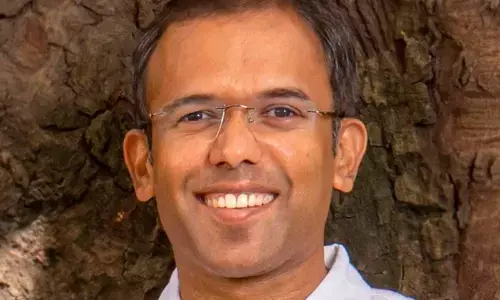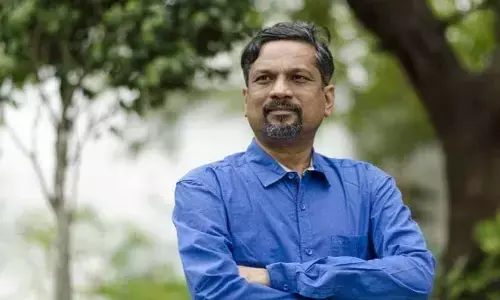An Era of Darkness: The British Empire in India is about Exploring the British Raj

Shashi Tharoor won the Sahitya Akademi Award 2019 for his book ‘An Era of Darkness: The British Empire in India’ on December 18. In the book Shashi Tharoor attempts to correct many misconceptions about one of the most contested periods of Indian history. In this extract he talks about British manufacturing in the Indian market…
Shashi Tharoor won the Sahitya Akademi Award 2019 for his book 'An Era of Darkness: The British Empire in India' on December 18. In the book Shashi Tharoor attempts to correct many misconceptions about one of the most contested periods of Indian history. In this extract he talks about British manufacturing in the Indian market…
In power, the British were, in a word, ruthless. They stopped paying for textiles and silk in pounds brought from Britain, preferring to pay from revenues extracted from Bengal, and pushing prices still lower. They squeezed out other foreign buyers and instituted a Company monopoly. They cut off the export markets for Indian textiles, interrupting long-standing independent trading links. As British manufacturing grew, they went further. Indian textiles were remarkably cheap—so much so that Britain's cloth manufacturers, unable to compete, wanted them eliminated. The soldiers of the East India Company obliged, systematically smashing the looms of some Bengali weavers and, according to at least one contemporary account (as well as widespread, if unverifiable, belief), breaking their thumbs so they could not ply their craft.
Crude destruction, however, was not all. More sophisticated modern techniques were available in the form of the imposition of duties and tariffs of 70 to 80 percent on whatever Indian textiles survived, making their export to Britain unviable. Indian cloth was thus no longer cheap. Meanwhile, bales of cheap British fabric—cheaper even than poorly paid Bengali artisans could make—flooded the Indian market from the new steam mills of Britain. Indians could hardly impose retaliatory tariffs on British goods, since the British controlled the ports and the government, and decided the terms of trade to their own advantage.
India had enjoyed a 25 percent share of the global trade in textiles in the early eighteenth century. But this was destroyed; the Company's own stalwart administrator Lord William Bentinck wrote that 'the bones of the cotton weavers were bleaching the plains of India'.
India still grew cotton, but mainly to send to Britain. The country no longer wove or spun much of it; master weavers became beggars. A stark illustration of the devastation this caused could be seen in Dhaka, once the great centre of muslin production, whose population fell from several lakhs in 1760 to about 50,000 by the 1820s. (Fittingly, Dhaka, now the capital of Bangladesh, is once again a thriving centre of textile and garment production.)
British exports of textiles to India, of course, soared. By 1830 these had reached 60 million yards of cotton goods a year; in 1858 this mounted to 968 million yards; the billion yard mark was crossed in 1870—more than three yards a year for every single Indian, man, woman or child.
The destruction of artisanal industries by colonial trade policies did not just impact the artisans themselves. The British monopoly of industrial production drove Indians to agriculture beyond levels the land could sustain. This in turn had a knock-on effect on the peasants who worked the land, by causing an influx of newly disenfranchised people, formerly artisans, who drove down rural wages. In many rural families, women had spun and woven at home while their men tilled the fields; suddenly both were affected, and if weather or drought reduced their agricultural work, there was no back-up source of income from cloth. Rural poverty was a direct result of British actions.
Apologists for Empire suggest that Indian textiles were wiped out by the machines of Britain's Industrial Revolution, in the same way that traditional handmade textiles disappeared in Europe and the rest of the world, rather than by deliberate British policy: in this reading, if they hadn't collapsed to British power, the weavers would have been replaced within fifty years by Indian textile mills using modern machinery. India's weavers were, thus, merely the victims of technological obsolescence.
It is plausible that, in due course, handlooms would have found it difficult to compete with mass-produced machine-made textiles, but they would surely have been able to hold on to a niche market, as they do to this day in India. At least the process would have occurred naturally and gradually in a free India, perhaps even delayed by favourable protective tariffs on English imports of mill-made textiles, rather than being executed brutally by British fiat. And many Indian manufacturers would surely have imported technology themselves, given the chance to upgrade their textile units; the lower wages of Indian workers would always have given them a comparative advantage over their European competitors on a level playing field. Under colonialism, of course, the playing field was not level, and the nineteenth century told the sad tale of the extinction of Indian textiles and their replacement by British ones.
Still, inevitably, Indian entrepreneurs began to set up their own modern textile mills after 1850 and to produce cloth that could compete with the British imports. The American Civil War, by interrupting supplies of cotton from the New World, set off a brief boom in Indian cotton, but once American supplies resumed in 1865, India again suffered. As late as 1896, Indian mills produced only 8 percent of the total cloth consumed in India. By 1913, this had grown to 20 percent, and the setbacks faced by Britain with the disruptions of the World War I allowed Indian textile manufacturers to slowly recapture the domestic market. In 1936, 62 percent of the cloth sold in India was made by Indians; and by the time the British left the country, 76 percent (in 1945).
But for most of the colonial era, the story of Indian manufacturing was of dispossession, displacement and defeat. What happened to India's textiles was replicated across the board. From the great manufacturing nation described by Sunderland, India became a mere exporter of raw materials and foodstuffs, raw cotton, as well as jute, silk, coal, opium, rice, spices and tea. With the collapse of its manufacturing and the elimination of manufactured goods from its export rosters, India's share of world manufacturing exports fell from 27 percent to 2 percent under British rule. Exports from Britain to India, of course, soared, as India's balance of trade reversed and a major exporting nation became an importer of British goods forced upon the Indian market duty-free while British laws and regulations strangled Indian products they could not have fairly competed against for quality or price.
The deindustrialization of India, begun in the late eighteenth century, was completed in the nineteenth and only slowly reversed in the twentieth. Under the British, the share of industry in India's GDP was only 3.8 percent in 1913, and at its peak reached 7.5 percent when the British left in 1947. Similarly, the share of manufactured goods in India's exports climbed only slowly to a high of 30 percent in 1947. And at the end of British rule, modern industry employed only 2.5 million people out of India's population of 350 million.
- Extracted with permission from Aleph Book Company.



















